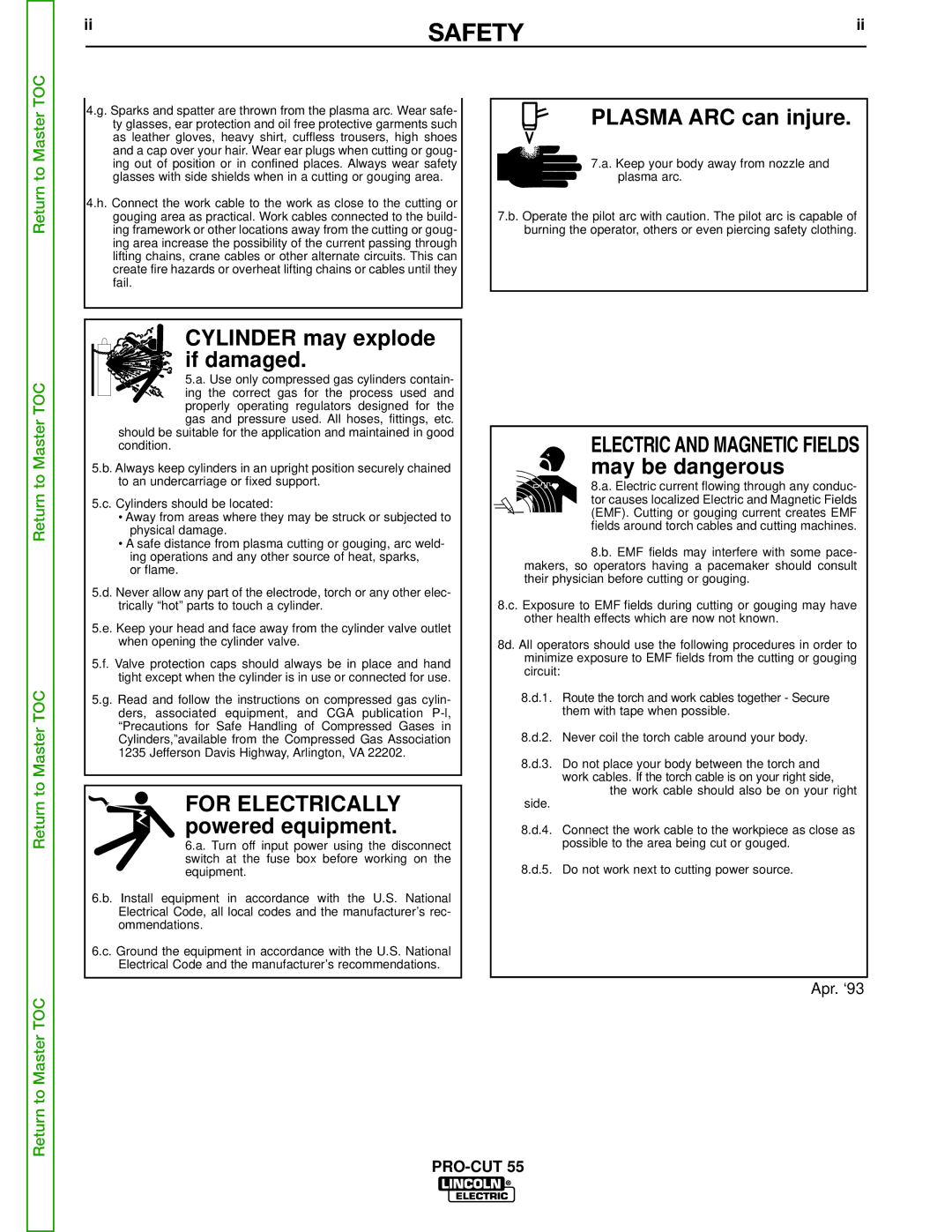
ii | SAFETY | ii | |
|
|
| |
Return to Master TOC
4.g. Sparks and spatter are thrown from the plasma arc. Wear safe- ty glasses, ear protection and oil free protective garments such as leather gloves, heavy shirt, cuffless trousers, high shoes and a cap over your hair. Wear ear plugs when cutting or goug- ing out of position or in confined places. Always wear safety glasses with side shields when in a cutting or gouging area.
4.h. Connect the work cable to the work as close to the cutting or gouging area as practical. Work cables connected to the build- ing framework or other locations away from the cutting or goug- ing area increase the possibility of the current passing through lifting chains, crane cables or other alternate circuits. This can create fire hazards or overheat lifting chains or cables until they fail.
PLASMA ARC can injure.
7.a. Keep your body away from nozzle and plasma arc.
7.b. Operate the pilot arc with caution. The pilot arc is capable of burning the operator, others or even piercing safety clothing.
Return to Master TOC
Return to Master TOC
Return to Master TOC
CYLINDER may explode if damaged.
5.a. Use only compressed gas cylinders contain-
ing the correct gas for the process used and properly operating regulators designed for the gas and pressure used. All hoses, fittings, etc.
should be suitable for the application and maintained in good condition.
5.b. Always keep cylinders in an upright position securely chained to an undercarriage or fixed support.
5.c. Cylinders should be located:
•Away from areas where they may be struck or subjected to physical damage.
•A safe distance from plasma cutting or gouging, arc weld- ing operations and any other source of heat, sparks,
or flame.
5.d. Never allow any part of the electrode, torch or any other elec- trically “hot” parts to touch a cylinder.
5.e. Keep your head and face away from the cylinder valve outlet when opening the cylinder valve.
5.f. Valve protection caps should always be in place and hand tight except when the cylinder is in use or connected for use.
5.g. Read and follow the instructions on compressed gas cylin- ders, associated equipment, and CGA publication
FOR ELECTRICALLY powered equipment.
6.a. Turn off input power using the disconnect switch at the fuse box before working on the equipment.
6.b. Install equipment in accordance with the U.S. National Electrical Code, all local codes and the manufacturer’s rec- ommendations.
6.c. Ground the equipment in accordance with the U.S. National Electrical Code and the manufacturer’s recommendations.
ELECTRIC AND MAGNETIC FIELDS may be dangerous
8.a. Electric current flowing through any conduc- tor causes localized Electric and Magnetic Fields (EMF). Cutting or gouging current creates EMF fields around torch cables and cutting machines.
8.b. EMF fields may interfere with some pace- makers, so operators having a pacemaker should consult their physician before cutting or gouging.
8.c. Exposure to EMF fields during cutting or gouging may have other health effects which are now not known.
8d. All operators should use the following procedures in order to minimize exposure to EMF fields from the cutting or gouging circuit:
8.d.1. Route the torch and work cables together - Secure them with tape when possible.
8.d.2. Never coil the torch cable around your body.
8.d.3. Do not place your body between the torch and work cables. If the torch cable is on your right side,
the work cable should also be on your right
side.
8.d.4. Connect the work cable to the workpiece as close as possible to the area being cut or gouged.
8.d.5. Do not work next to cutting power source.
Apr. ‘93
